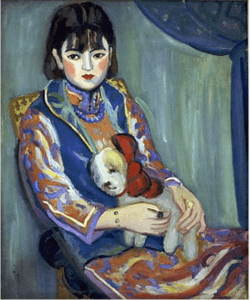Guan Zilan (关紫兰; January 1903 – 30 June 1986) was a Chinese avant-garde painter. She was born in Shanghai, China. She was one of the most famous female artists in China in the 20th century and was the first artist to introduce Fauvism to China. She was known for applying Western painting style to Chinese traditional subjects.
Her parents were successful textile merchants involved in textile design, which exposed Guan to artistic education since her childhood. She went to school at the Shanghai Shenzhou Girls’ school before attending the China Art University where she studied western painting under the famous artist, Chen Baoyi and Hong Ye. Guan Zilan went aboard to Japan at the Tokyo Institute of Culture: Bunka Gakuin, to pursue painting, after graduating in 1927. She was influenced a lot by western modern art, especially post-impressionism and, more notably, fauvism.
Guan became very famous both in Japan and China, she was regarded as the embodiment of the “modern girl,” as a female artist trained in western styles. After she returned to China, she became a professor at Shanghai art college. After 1949, when the communists took over China, she worked at the Shanghai Research Institute of Culture and History and became a member of China Artists. She changed her artistic style to align with socialist realism dominant in Communist China. She was a leader among female artists until the start of the Cultural Revolution in 1966 when she stopped painting.
Her most famous work is Portrait of Miss L. (1929).

Reference:
“Guan Zilan – 12 Artworks – Painting”. 2022. Www.Wikiart.Org. https://www.wikiart.org/en/guan-zilan.
“Guan Zilan – Chinese New Art – Chinesenewart”. 2022. Chinesenewart.Com. https://www.chinesenewart.com/chinese-artists15/guanzilan.htm.
“Guan Zilan – Wikipedia”. 2022. En.Wikipedia.Org. https://en.wikipedia.org/wiki/Guan_Zilan.


Leave a Reply
You must be logged in to post a comment.